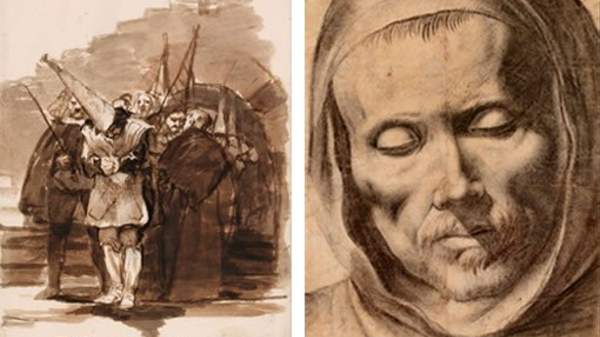Overview
Despite prominently featuring his name in the title, Renaissance to Goya is mostly etchings and sketches from predecessors and contemporaries of Francisco de Goya, with Goya's own art confined to the final of the show's four rooms.
Three quarters of the show is a pretty technical collection of nice art pieces occupied mainly with saints, angels and genitals. Hendrick Goltzius' the Circumcision of Christ (the minute blade and divine member dead centre) and Francisco Rizi's The Virgin appearing to Saint Simon de Rojas stand out particularly in the latter category. José de Ribera's Christ beaten by a tormentor shows a hazy, red chalk drawing image that feels like reportage from an Occupy police beating.
Much of the best stuff is saved for the final room. Most is by Goya himself, but Luis Parent y Alcazar's A Masked Ball is chock full of tiny faces at the titular ball, each alive with excitement as your eye climbs the private boxes amongst the candelabras. Fernando Brambila and Juan Gálvez's Ruins of the church of the General Hospital is a beautiful, shocking image, with arches broken halfway through their curve and beams askew, like poorly made barricades. It's like looking at a photo of ruined Europe from after the Second World War. It hangs next to Goya's images of war and a tired Duke of Wellington.
Goya's own figures are messy, delicate and expressive. For so many of his lighter subjects, these keen faces create comedy, pathos or pride. In his darker images, though, these feelings coalesce into sombre moments, like Edward Gorey sketches or an Art Spiegelman comic. The timing on the page, between Goya's images and titles, wouldn't feel out of place among the cartoons curated at the New Yorker by Spiegelman's wife Françoise Mouly. (Both of the latter are due here in October for GRAPHIC.)
The sleep of reason produces monsters, in the series Los caprichos, is almost reason enough by itself to visit the exhibition. A man asleep at his desk is stalked by looming owls, bats and big cats. Scared, off balance and shivering, he huddles across the left of the etching while the monsters gather around. Equally strong is his Disasters of War series, a posthumously published reaction to war, famine and an opressive regime. It's harsh, sarcastic and horrifying. What bravery! shows sacklike, dead men surrounding a cannon as a woman lights its fuse, alone. A heroic feat! With dead men shows two men hanging from a tree. They are in five parts. One of them is whole. These Goya are stunning.
But, while there are good things on show here, you want to be aware going in exactly how much on offer is Goya and how much renaissance.
Images: Francisco Goya Y Lucientes, For being of Jewish ancestry and Francisco de Zurbarán, Head of a monk © The Trustees of the British Museum
Information
When
Saturday, August 31, 2013 - Sunday, November 24, 2013
Saturday, August 31 - Sunday, November 24, 2013
Price
$10/8-
Event Type
